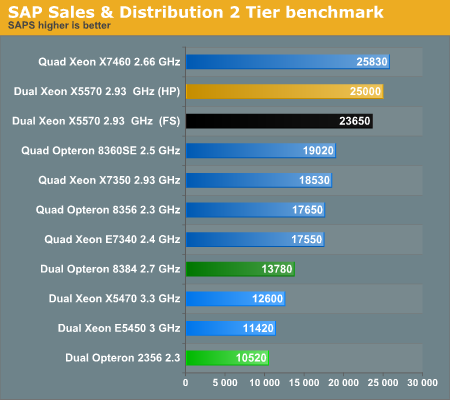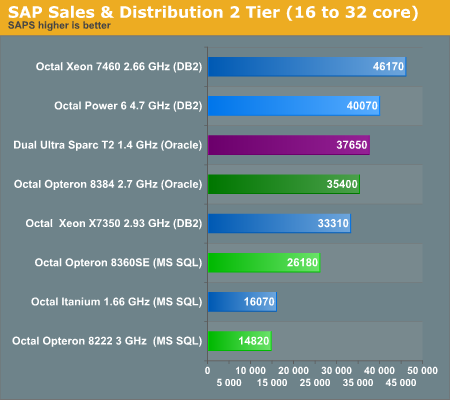The Best Server CPUs Compared, Part 1
by Johan De Gelas on December 22, 2008 10:00 PM EST- Posted in
- IT Computing
ERP and OLTP Benchmark 1: SAP S&D
The SAP S&D (sales and distribution, 2-tier internet configuration) benchmark is an extremely interesting benchmark as it is a real world client-server application. We decided to look at SAP's benchmark database. The results below are two tier benchmarks, so the database and the underlying OS can make a big difference. Unless we keep those parameters the same, we cannot compare the results. The results below are all run on Windows 2003 Enterprise Edition and MS SQL Server 2005 database (both 64-bit). Every "two tier Sales & Distribution" benchmark was performed on the SAP's "ERP release 2005".
In our previous server oriented article, we summed up a rough profile of SAP S&D:
- Very parallel resulting in excellent scaling
- Low to medium IPC, mostly due to "branchy" code
- Not really limited by memory bandwidth
- Likes large caches
- Sensitive to sync ("cache coherency") latency

There are no quad socket results for the latest 45nm AMD parts, but we can still get a pretty good idea where it would land. The "Barcelona" Opteron scales from 10520 SAPS (2 CPUs) to 17650 (4 CPUs), or an improvement of about 68%. The quad Opteron 8384 will probably scale a bit better, so we speculate it will probably attain a score of about 23000 to 24000 SAPS. It won't beat the best Intel score (Dunnington), but it will come close enough and offer an excellent performance/watt ratio. If you are wondering about the phenomenal Xeon X5570 scores, we discussed them here.
Also interesting is that the dual 2.7GHz "Shanghai" is about 31% faster than the dual 2.3GHz "Barcelona", while the clock speed advantage is only 17%. It clearly shows that the larger L3 cache pays off here. Now let's look at some more exotic setups: octal socket or similar systems.

This overview is hardly relevant if you are deciding which x86 server to buy, but it is a feast for those following the complete server market -- or those of us who are interested in different CPU architectures. There is a battle raging between three different philosophies: the thread machine-gun SUN UltraSPARC T2, the massive speed daemon IBM POWER6, and the cost effective x86 architectures. The UltraSPARC 2 machine only has four sockets, but each socket contains eight CPUs that have a fine grained multithreaded, in order, "Gatling gun" that cycles between eight threads. That means one quad socket machine keeps up to 256 threads alive. The POWER6 machine contains eight CPUs, but each CPU is only a dual-core CPU. However, each POWER6 CPU is a deeply pipelined, wide superscalar architecture running at 4.7GHz, backed up with massive caches (4MB L2, 32MB L3). The very wide superscalar architecture is used more efficiently thanks to Simultaneous Multi-Threading (SMT).
Each T2 with eight "mini cores" needs 95W compared to 130W for two massive POWER6 cores, so the SUN Server needs 4 x 95W for the CPUs, while the IBM server needs 8 x 130W. These differences could be smaller percentagewise when you look at how much power each server system will need, but when it comes to performance/watt, it will be hard to beat the T2 here. The latest octal Opteron server should come close (8 x 75W) as it does not use FB-DIMMs while the UltraSPARC T2 does. However, we are speculating here; let's get back to our own benchmarking.










29 Comments
View All Comments
Bruce Herndon - Tuesday, December 23, 2008 - link
I'm surprised by your comments. You claim that VMmark is a CPU/memory-centric benchmark. If I look at the raw data in the VMmark disclosure for Dell's R905 score of 20.35 @ 14 tiles, I see that the benchmark is driving 250-300 MB/s of disk IO across several HBAs and storage LUNs. This characteristic scales with the various systems mentioned in the article.As a designer of VMmark, I happen to know that both storage bandwidth (for the fileserver) and latency (for mail and database)are critical to acheiving good VMmark scores. Furthermore, the webserver drives substantial network IO. The only purely CPU-centric component to VMmark is the javaserver. Overall, the benchmark does exercise the entire virtualization solution - hypervisor, CPU, memory, disk, and network.
cdillon - Tuesday, December 23, 2008 - link
While SAS and Infiniband share some connectors and obtain similar data rates, they are incompatible technologies with two different purposes. Infiniband can be used for disk shelf connections, but it is less common and definitely not the case here. You should not call the connection between the Adaptec 5805 controller and the disk shelf an "Infiniband connection", even if it is using Infiniband connectors and cables, it is simply an SAS connection.JohanAnandtech - Tuesday, December 23, 2008 - link
Well, the physical layer is Infiniband, the used protocol is SCSI. I can understand calling it an "infiniband connection" maybe confusing, but the cable is an infiniband cable.shank15217 - Friday, December 26, 2008 - link
Anand, I think the above poster is right. The Adaptec RAID 5805 uses SFF-8087 connectors but the protocol is SSP (Serial SCSI Protocol). Infiniband is a physical layer protocol that shares the same connector as SAS but they are not the same. Nothing in the Adaptec RAID 5805 spec mentions Infiniband as a supported protocol.http://www.adaptec.com/en-US/products/Controllers/...">http://www.adaptec.com/en-US/products/C...ers/Hard...
niva - Tuesday, December 23, 2008 - link
I'm not sure you can run your same ol benchmark for rendering, and I'd really like more insight into what you guys are rendering and if it's indeed using all 16/24(six core 4 point system)/32(hyperthreading) cores on the system.What renderer, what scene, details details...
These chips get gobbled up by render farms and this is indeed where they can really flex their muscles to the fullest.
JohanAnandtech - Tuesday, December 23, 2008 - link
Just click on the link under "we have performed so many times before" :-)akinneyww - Tuesday, December 23, 2008 - link
I read DailyTech and anandtech.com to keep up with the latest in IT. I appreciate the thought that has gone into putting together this article. I would like to see more articles like this one.Jammrock - Tuesday, December 23, 2008 - link
The VMware results shocked me the most. I know AMD has been working hard on the virtualization sector and it looks like their work has paid off.classy - Tuesday, December 23, 2008 - link
With the rapid increase of virtualization, AMD is looking really strong. We have begun using 3.5 Vmware and are expanding the use of it. Virtualization is truly becoming a big thing in server choice.